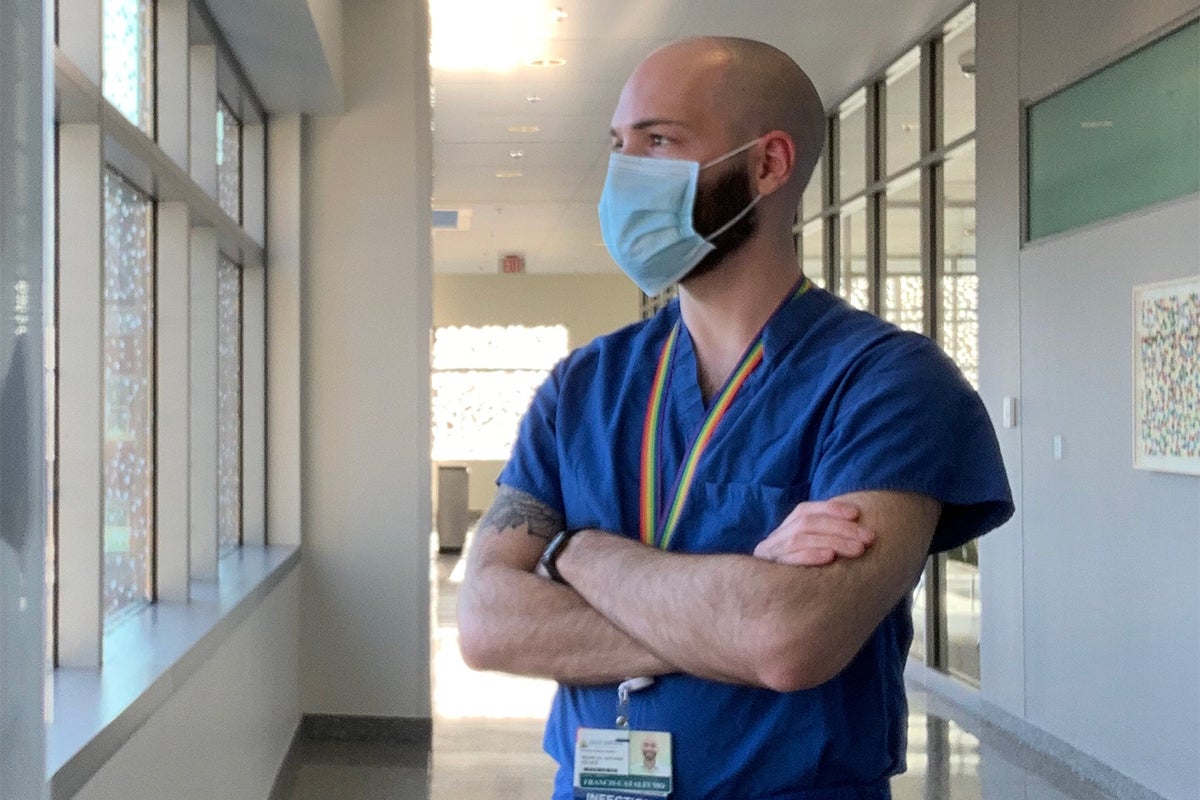Frankie Catalfumo ’13 has worked through outbreak responses to cholera in Haiti and Ebola virus disease in the United States, but he says the current coronavirus (COVID-19) pandemic is more stressful than any of his other work with controlling infectious diseases.
“You see the waves in China and then we started to see it spread across the globe,” says Catalfumo, an infection control epidemiologist in the Department of Hospital Epidemiology and Infection Control at the Johns Hopkins Hospital in Baltimore. “You have a warning of what’s to come and you’re just waiting to see what the next day will bring as you see more and more cases pop up in your own state.” As of April 21, Maryland has had 13,684 cases positive for and 582 deaths due to COVID-19, according to data compiled by the Center for Systems Science and Engineering at Johns Hopkins University.
“You have a warning of what’s to come and you’re just waiting to see what the next day will bring.”
For the general public, controlling the spread of the virus mainly consists of practicing excellent hand hygiene, social distancing and staying home. But in hospitals across the nation, healthcare professionals must consider many other factors to keep patients, themselves and everyone else safe. It’s Catalfumo’s job to help develop the necessary infection prevention and control practices to ensure safety is maintained.
“A hospital’s kind of like a sick hotel, so patients being admitted may have some type of infection and risk of spreading it,” says the health sciences graduate. “Now is an especially important time for healthcare providers and other frontline staff to collaborate on identifying how this particular infection may be communicable to everyone in the hospital, and outside of it.”
His recent workdays consist as much of being responsive to the many matters that evolve daily as of thinking ahead on potential obstacles. One of the biggest issues hospitals across the nation are dealing with is providing essential personal protective equipment (PPE) for healthcare workers. Catalfumo has helped establish guidance at his hospital.
“In a pandemic, it is crucial to know how to clean specific PPEs, such as face shields, so we can reuse them,” he says. “Knowing which type of equipment can be reused and how it can be cleaned will help the hospital mindful use our supplies.”
Catalfumo also has to consider routes that minimize contact between patients and others, proper laboratory specimen collection and transport, and problem-solving with staff on personal concerns, such as what to tell family members now that they’re working with COVID-19 patients.
“Epidemiologists frequently work behind the scenes and if an outbreak doesn’t become very notable that’s because they were able to intervene.”
Before working at Johns Hopkins, Catalfumo worked as a consultant for the Department of Defense and the Centers for Disease Control and Prevention. While studying at UCF, he volunteered with International Medical Outreach (IMO), a student-led nonprofit organization that specializes in medical service and shadowing trips in impoverished areas around the world. It was with IMO that he gained his first experience working hands-on with epidemiology in Haiti and subsequently motivated him to pursue a master’s degree in public health.
“All disasters and all public health emergencies are incredibly interdisciplinary. Even if you’re working with an issue that appears simple or more readily understood, such as cholera, or one that’s new and evolving, such as COVID-19, you have to be able to adapt and be flexible when responding to the event,” Catalfumo says.
For epidemiologists, a job well done is often one that the majority of people can’t tell has even happened.
“Epidemiologists frequently work behind the scenes and if an outbreak doesn’t become very notable that’s because they were able to intervene,” he says. “It requires providing a lot of hands-on, in-the-moment education, to make sure everybody has the information they need to feel very safe caring for patients.”
“It’s a marathon, not a sprint. We need to make sure we’re going to be at our best and be prepared in our response.”
When it comes to making sure the general public has the knowledge they need, he suggests referencing the CDC website on a frequent basis to get the most accurate and up-to-date information available.
Like many other healthcare professionals, Catalfumo can feel the strain of the everchanging conditions in hospitals. To remain on top of their responsibilities, he knows it’s essential to maintain another good practice off the clock.
“Right now, it’s important for healthcare workers to practice self-care because we’re just beginning,” he says. “It’s a marathon, not a sprint. We need to make sure we’re going to be at our best and be prepared in our response.”




